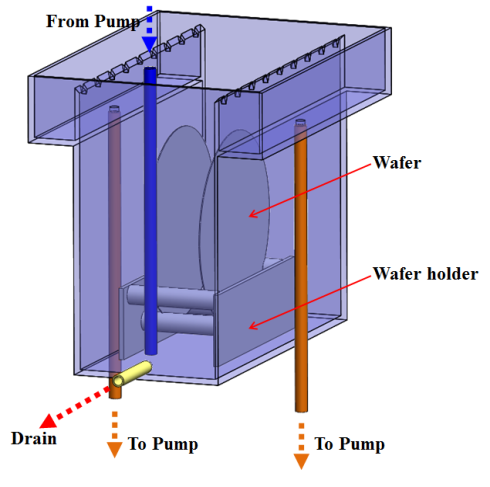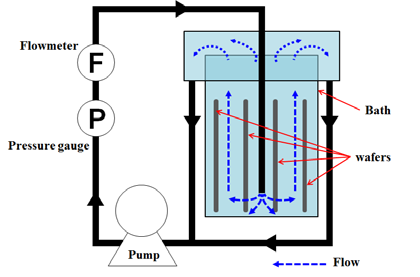The effects of pumping method on wafer cleaning were investigated. Two types of pump such as diaphragms and centrifugal were used for circulation and supply of DI water for wafer cleaning in both wet bath and single wafer tool. The cleaning studies show that the pumping methods have a great influence on cleaning performance. The experimental investigations reveal that the number of added particles on the wafer during wafer cleaning is much lesser in MLC pump (non-pulsation flow) than the both diaphragm pumps (pulsation flow).
The source of particle generation can be largely divided into four categories: environment, personnel, materials, and equipment/process. The proportion of wafer surface contamination varies according to the type of process and production line level. In the clean room, the probability of particles contamination to the wafer surface is low, in the actual process there are quite a lot of particles adhered to the wafer, which results in yield reduction. The sources of these particles are neither air nor humans, but rather the materials and manufacturing equipment. As particle emission from manufacturing equipment in particular has increased noticeably, and has become the largest cause of decreases in yield (1-2). Nearly all the cleaning and surface conditioning processes are done in the liquid phase, and majority of these processes are aqueous (3). Various types of pump such as bellows, diaphragms and centrifugal have been used in microelectronic processing industries for range of applications. In principle, the flow delivery is pulsatile in positive displacement pumps (bellow and diaphragms) whereas continuous in magnetic levitation pumps. This would influence the performance of various processes in surface preparation such as cleaning and etching etc. The operation of pump generates particles because of moving parts such as diaphragms and the seating of the valve (4). On the other side, various factors cause the particle agglomeration when the liquid is subjected to circulation through pump which includes shear stress, mechanical contact between slurry and the pump and cavitation. Shear stress exhibits on the liquid when it is subjected to high velocity gradients. For example, flow though orifice and orifice meter and flow across a diaphragm seat. The degree of level of agglomeration depends on inter particle force, external shear stress which in turn depends on type of pump that used in the process line and number of turnovers of slurry (5). However, shear stress also breaks loose agglomerates. The dominating mechanism is determined by the magnitude of shear level imparted to the liquid and the force of attraction /repulsion between particles [3]. In the case of positive displacement pump, high shear flow increases the oversized particle [5] thereby affects the process efficiency. In summary, the pumping methods affect the semiconductor manufacturing process considerably. The main objective of the work is to find the effect of pumping methods on wafer cleaning process.
Eight inch (200 mm) bare Si wafers were used as substrates. Prior to the experiments, wafers were cleaned with ammonia peroxide mixtures (SC1) with megasonic for 10 minutes in wet bath and spin dried for 30 seconds to ensure that the surface is hydrophilic. Before and after cleaning, the total number of particles on wafer was counted for the evaluation of particle removal efficiency (PRE) by surface particle scanner (Surfscan 6200, KLA-Tencor, USA). Wet cleaning was performed in both wet bath (200/300mm, lab.-made) and single wafer processor (Goldfinger, Akrion, USA). using various types of pump such as traditional diaphragms (D1 and D2) and magnetic levitation centrifugal (MLC) pump (BPS 600, Levitronix, USA). All experiments were conducted in a class-10 cleanroom (R.H. 50%, Temp. 25℃).
The Effects of Pumping Method on Wafer Cleaning in Wet Bath The schematic diagram and photograph of experimental set up is shown in Fig. 1. The flow rate and pressure of the circulation system was monitored by flow meter and pressure gauge respectively without damper and valves. Three pumps were tested in the present work after connecting the pump to the circulation line. The whole system is flushed with DI water for 24 hours before the actual run in order to remove the particles generated during the initial pumping.


上一篇: 评估兆声波清洗系统的颗粒去除效率和破坏性
下一篇: 湿法清洗中颗粒去除的新概念